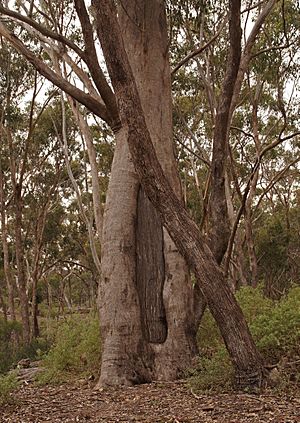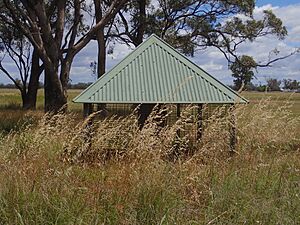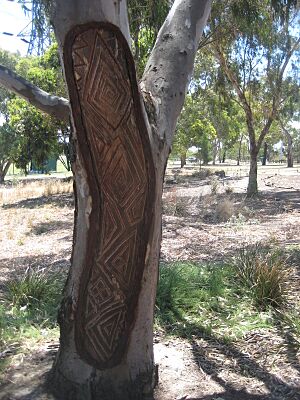Scarred tree facts for kids
A scarred tree is a tree where bark has been carefully removed by Aboriginal people. They did this to create many useful items like bark canoes, temporary shelters, shields, tools, traps, and containers called coolamons. These trees are also known as scar trees, canoe trees, or shield trees.
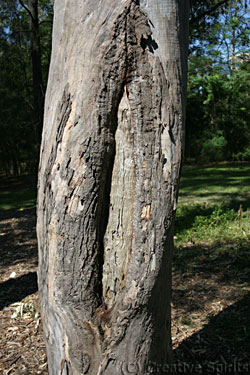
Carved trees are different. They were made by some Aboriginal groups as a form of art and spiritual expression. These carvings often marked important places, like burial sites.
What Are Scarred Trees?
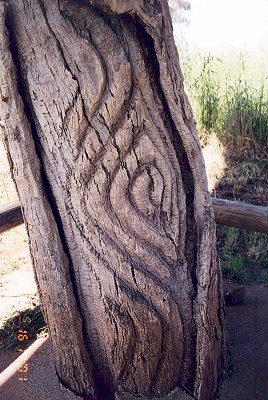
Aboriginal people removed bark by making deep cuts into a tree. They used tools like stone axes. The part of the bark they took was usually a regular shape. It often had parallel sides and pointed or rounded ends. The scar usually started above the ground.
Australian native trees, especially eucalypts like box and red gum, were often used. These trees are common in places like Victoria. Scars can still be seen on trees that are over 200 years old. Sometimes, you can see the inner wood (called sapwood) at the top or bottom of the scar. This shows the axe cuts.
Aboriginal people used the bark to make many things. This included canoes for travel, containers for carrying food or water, and shields for protection. They also built temporary shelters from bark. Sometimes, they cut small toe holds into trees. This helped them climb easily. They used these trees as lookouts or to find bush foods.
To get the bark, Aboriginal people first cut an outline of the shape they wanted. They used stone axes. Later, after Europeans arrived, they sometimes used steel axes. Then, they carefully pulled the bark off. Sometimes, you can still see the axe marks on the tree's sapwood. But often, new bark grows over these marks. The amount of new bark can help guess how old the scar is. Very old scars might be completely covered by new growth.
People who were not Indigenous Australians called these marked trees "scarred trees," "scar trees," "canoe trees," or "shield trees." In the 17th century, dugout canoes started to appear in Australia. These were different from bark canoes. They changed how Aboriginal people hunted and lived.
What Are Carved Trees?
Carved trees are mostly found in New South Wales. They were made by artists from the Gamilaroi and Wiradjuri peoples. These trees were carved to mark special places for ceremonies. This included places for initiation rituals or burial sites. They are also known by other names like arborglyphs or dendroglyphs.
During the 1800s, some parts of these carved trees were taken. They were put into museums. But now, there is a movement to return these tree sections to their original lands. There is also an effort to bring back the tradition of carving trees.
Where Can You Find Them?
Scarred trees are found among old native trees. You can often see them near box gum and red gum trees. They are usually located along rivers and lakes. They can also be found at sacred sites. These important trees are protected by law.
Canoe trees have been photographed along the Murray River. You can find them at Waikerie and Kroehns Landing in Nildottie, South Australia. They are also on the Murrumbidgee River near Hay, New South Wales.
RMIT University in Bundoora, Victoria, has six scarred trees on its campus. They have created a self-guided tour trail. You can also find information about these trees on their website.
See also
- Australian Aboriginal artefacts
- Leaf scar


